Mongolian barbecue is not really Mongolian cuisine, and Genghis Khan of the Mongol Empire probably never had it while trying to conquer the world. And it has little to do with barbecue. The dish was developed in Taiwanese restaurants more than half a century ago, and the term was coined by legendary crosstalk performer Wu Zhao-nan (吳兆南) in 1951 when he opened a barbecue eatery in Taipei.
Established in the 1960s, Genghis Khan Mongolian Bar-B-Q is the oldest restaurant that specializes in the stir-fried dish today. It is about a 10-minute walk from Zhongshan MRT Station (中山站). The first floor of the two-story restaurant is closed during weekdays, so my family and I were seated at two round tables on the second floor for dinner.
At Genghis Khan, you first choose ingredients from a display of meats, vegetables and sauces to create your own bowl. You then hand it to a chef, who cooks it in front of you on a giant circular iron griddle. The restaurant provides four varieties of meat: beef, pork, lamb and chicken. They are thinly sliced and neatly piled in four containers on a counter. It also offers nine varieties of vegetables: basil, bean sprouts, cabbage, carrots, onions and green onions, pineapples, tomatoes and water spinach.
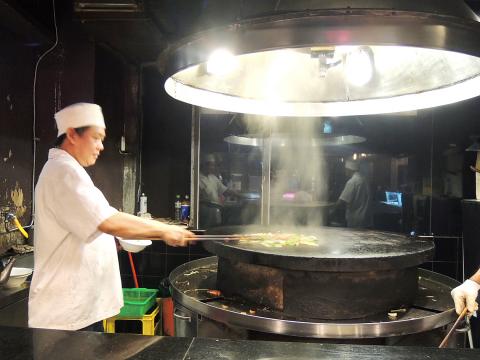
Photo: Eddy Chang, Taipei Times
I had some beef and lamb, and a little bit of everything from the vegetable counter, so my creation looked colorful. It is said that an enzyme in pineapple can tenderize meat, so I added a few slices to my bowl.
Next, I moved to the counter where various sauces were displayed. All the labels for the sauces are written in Chinese and English, with suggested amounts for each. A chef told me that soy-bean sauce, shrimp oil, sesame oil and rice wine were the most commonly used, so I took one teaspoon of each and added some garlic and chilies just to spice things up.
Finally, I handed my bowl to one of the two chefs at the semi-open kitchen next to the sauce counter. The chef skillfully stirred all the ingredients on the griddle and added some water to ease cooking. The sizzling sound and tempting smell immediately aroused my appetite. The chef said that the temperature of the griddle could be as high as 800 degrees Celsius, so they moved fast during the cooking process.
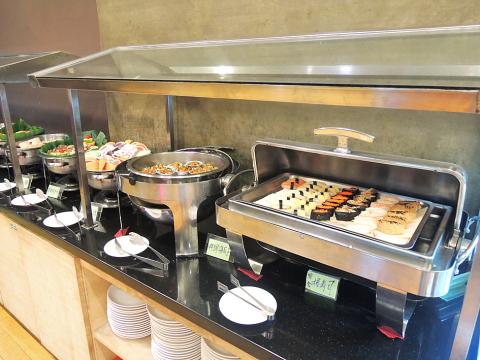
Photo: Eddy Chang, Taipei Times
Within a minute, my Mongolian barbecue was ready. The quickly stir-fried beef and lamb were quite tender with a robust meat flavor. Since the chef added some water during the stir-frying, the vegetables did not dry out. But I realized that I added too much soy sauce because my barbecue was a little too salty. A traditional way of eating Mongolian barbecue is putting it in a baked sesame seed coated cake. My cake was crispy and flavorful.
Apart from the Mongolian barbecue, additional buffet items were available, including a mini salad bar, a good selection of appetizers and seven dishes. My favorite appetizer was mixed meat jelly; the mix and chilled jelly-like broth were a good match. Other dishes on the night we dined included a nigiri sushi combo (綜合握壽司), seasoned Venus clams (特調海瓜子), boiled neritic squid (美味軟絲), sea bream with teriyaki sauce (照燒鯛魚排), free-range chicken with green onion oil (油蔥土雞), boiling water scalded shrimps (白灼鮮蝦) and abalone salad (鮑魚沙律). All the seafood dishes were fresh and well cooked. Genghis Khan also has a variety of drinks, desserts and fruit to finish off the meal — though the former two weren’t anything to write home about.
There are three prices for the dinner buffet: NT$520 for an adult, NT$270 for a child (between 110cm and 140cm tall) and NT$120 for a young child (below 110cm), along with a 10-percent service charge. For lunch buffet during weekdays, it is only NT$420 for an adult. Overall, Genghis Khan was an enjoyable dining experience, and its authentic Taiwanese-style Mongolian barbecue deserves a try.
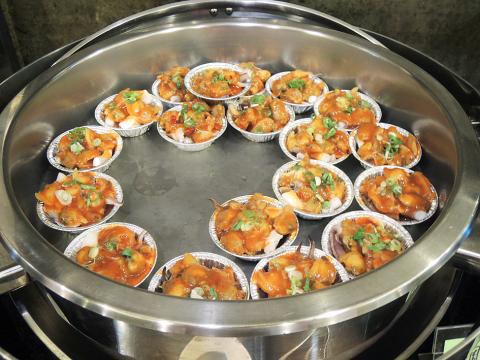
Photo: Eddy Chang, Taipei Times

Photo: Eddy Chang, Taipei Times

Following the rollercoaster ride of 2025, next year is already shaping up to be dramatic. The ongoing constitutional crises and the nine-in-one local elections are already dominating the landscape. The constitutional crises are the ones to lose sleep over. Though much business is still being conducted, crucial items such as next year’s budget, civil servant pensions and the proposed eight-year NT$1.25 trillion (approx US$40 billion) special defense budget are still being contested. There are, however, two glimmers of hope. One is that the legally contested move by five of the eight grand justices on the Constitutional Court’s ad hoc move
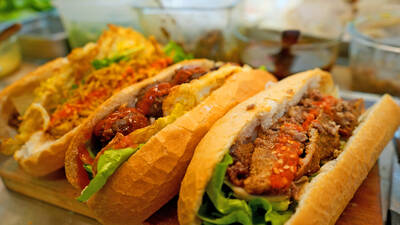
Stepping off the busy through-road at Yongan Market Station, lights flashing, horns honking, I turn down a small side street and into the warm embrace of my favorite hole-in-the-wall gem, the Hoi An Banh Mi shop (越南會安麵包), red flags and yellow lanterns waving outside. “Little sister, we were wondering where you’ve been, we haven’t seen you in ages!” the owners call out with a smile. It’s been seven days. The restaurant is run by Huang Jin-chuan (黃錦泉), who is married to a local, and her little sister Eva, who helps out on weekends, having also moved to New Taipei

The Directorate-General of Budget, Accounting and Statistics (DGBAS) told legislators last week that because the Chinese Nationalist Party (KMT) and Taiwan People’s Party (TPP) are continuing to block next year’s budget from passing, the nation could lose 1.5 percent of its GDP growth next year. According to the DGBAS report, officials presented to the legislature, the 2026 budget proposal includes NT$299.2 billion in funding for new projects and funding increases for various government functions. This funding only becomes available when the legislature approves it. The DGBAS estimates that every NT$10 billion in government money not spent shaves 0.05 percent off
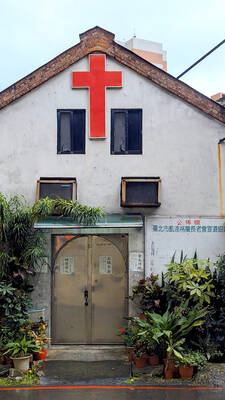
Dec. 29 to Jan. 4 Like the Taoist Baode Temple (保德宮) featured in last week’s column, there’s little at first glance to suggest that Taipei’s Independence Presbyterian Church in Xinbeitou (自立長老會新北投教會) has Indigenous roots. One hint is a small sign on the facade reading “Ketagalan Presbyterian Mission Association” — Ketagalan being an collective term for the Pingpu (plains Indigenous) groups who once inhabited much of northern Taiwan. Inside, a display on the back wall introduces the congregation’s founder Pan Shui-tu (潘水土), a member of the Pingpu settlement of Kipatauw, and provides information about the Ketagalan and their early involvement with Christianity. Most